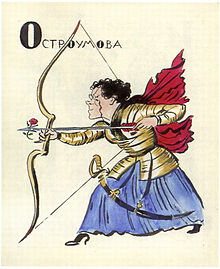O (О о; italics: О о) is a letter of the Cyrillic script.

The letter most commonly represents the sound /ɔ/, like the o in "off". In Russian and Serbo-Croatian, it represents the sound /o/.
History
editThe Cyrillic letter О was derived from the Greek letter Omicron (Ο ο).
Form
editModern fonts
editIn modern-style typefaces, the Cyrillic letter O looks exactly like the Latin letter O ⟨O o⟩ and the Greek letter Omicron ⟨Ο ο⟩.
Church Slavonic printed fonts and Slavonic manuscripts
editHistorical typefaces (like poluustav (semi-uncial), a standard font style for the Church Slavonic typography) and old manuscripts represent several additional glyph variants of Cyrillic O, both for decorative and orthographic (sometimes also "hieroglyphic"[1]) purposes, namely:
- broad variant (Ѻ/ѻ), used mostly as a word initial letter (see Broad On for more details);
- narrow variant, being used now in Synodal Church Slavonic editions as the first element of digraph Oy/oy (see Uk (Cyrillic) for more details), and in the editions of Old Believers for unstressed "o" as well;
- variant with a cross inside (Crossed O), Ꚛ, used in certain manuscripts as the initial letter of words окрестъ 'around, nearby' (the root of this Slavonic word, крест, means 'cross') and округъ 'district, neighbourhood' with their derivatives;
- "eyed" variant (Monocular O) with a dot inside (Ꙩ/ꙩ), used in certain manuscripts in spelling of word око 'eye' and its derivatives. In many other texts, including the birchbark letters, the monocular O was not used as a hieroglyph but largely as a synonym of Broad On signalling the word-initial position;
- "two-eyed" variants (Binocular O) with two dots inside (Ꙫ/ꙫ or Ꙭ/ꙭ), also double "O" without dots inside were used in certain manuscripts in spelling of dual/plural forms of the words with the same root 'eye';
- "many-eyed" variant (Multiocular O), ꙮ, used in certain manuscripts in spelling of the same root when embedded into word многоочитый 'many-eyed' (an attribute of seraphim).
Usage
editIn Russian, O is used word-initially, after another vowel, and after non-palatalized consonants. Because of a vowel reduction processes, the Russian /o/ phoneme may have a number of pronunciations in unstressed syllables, including [ɐ] and [ə].
In Macedonian, Bulgarian, Ukrainian and Belarusian, the letter represents the sound /ɔ/.
In Tuvan the Cyrillic letter can be written as a double vowel.[2][3] It's the most common letter in the Russian language.[4]
Related letters and other similar characters
edit- Ο ο : Greek letter Omicron
- O o : Latin letter O
- Ó ó : Latin letter Ó
- 0 : Digit Zero
- Ё ё : Cyrillic letter Yo
- Ѻ ѻ : Cyrillic letter Broad On
- Ӧ ӧ : Cyrillic letter O with diaeresis
- Ө ө : Cyrillic letter Oe
- Ӫ ӫ : Cyrillic letter Oe with diaeresis
- Ҩ ҩ : Cyrillic letter O-hook
Computing codes
edit| Preview | О | о | ||
|---|---|---|---|---|
| Unicode name | CYRILLIC CAPITAL LETTER O | CYRILLIC SMALL LETTER O | ||
| Encodings | decimal | hex | dec | hex |
| Unicode | 1054 | U+041E | 1086 | U+043E |
| UTF-8 | 208 158 | D0 9E | 208 190 | D0 BE |
| Numeric character reference | О |
О |
о |
о |
| Named character reference | О | о | ||
| KOI8-R and KOI8-U | 239 | EF | 207 | CF |
| Code page 855 | 215 | D7 | 214 | D6 |
| Windows-1251 | 206 | CE | 238 | EE |
| ISO-8859-5 | 190 | BE | 222 | DE |
| Macintosh Cyrillic | 142 | 8E | 238 | EE |
Exotic glyph variants of Cyrillic O are available only in Unicode:[5][6][7][8][9]
- broad Ѻ/ѻ:
- CYRILLIC CAPITAL LETTER ROUND OMEGA: U+047A
- CYRILLIC SMALL LETTER ROUND OMEGA: U+047B
- narrow ᲂ does not just represent itself, but also used in digraph Oy/oy:
- CYRILLIC SMALL LETTER NARROW O: U+1C82
- CYRILLIC CAPITAL LETTER UK: U+0478 (deprecated in favor of combination of Cyrillic letters О and у, U+041E U+0443)
- CYRILLIC SMALL LETTER UK: U+0479 (deprecated in favor of combination of Cyrillic letters о and у, U+043E U+0443 or U+1C82 U+0443)
- with a cross inside (Ꚛ/ꚛ):
- CYRILLIC CAPITAL LETTER CROSSED O: U+A69A
- CYRILLIC SMALL LETTER CROSSED O: U+A69B
- doubled Ꚙ/ꚙ:
- CYRILLIC CAPITAL LETTER DOUBLE O: U+A698
- CYRILLIC SMALL LETTER DOUBLE O: U+A699
- eyed Ꙩ/ꙩ:
- CYRILLIC CAPITAL LETTER MONOCULAR O: U+A668
- CYRILLIC SMALL LETTER MONOCULAR O: U+A669
- two-eyed (Ꙫ/ꙫ, Ꙭ/ꙭ):
- CYRILLIC CAPITAL LETTER BINOCULAR O: U+A66A
- CYRILLIC SMALL LETTER BINOCULAR O: U+A66B
- CYRILLIC CAPITAL LETTER DOUBLE MONOCULAR O: U+A66C
- CYRILLIC SMALL LETTER DOUBLE MONOCULAR O: U+A66D
- many-eyed ꙮ:
- CYRILLIC LETTER MULTIOCULAR O: U+A66E
- combining O for Church Slavonic abbreviations (as трⷪца = троица '(Holy) Trinity'):
- COMBINING CYRILLIC LETTER O: 2DEA
References
edit- ^ Карский, Ефим (1979). Славянская кирилловская палеография. Moscow.
{{cite book}}: CS1 maint: location missing publisher (link) - ^ "Tuvan language, alphabet and pronunciation". omniglot.com. Retrieved 14 June 2016.
- ^ Campbell, George L.; King, Gareth (24 July 2013). Compendium of the World's Languages. Routledge. ISBN 9781136258459. Retrieved 14 June 2016 – via Google Books.
- ^ "Новый частотный словарь русской лексики". Ruslang.ru (in Russian). Retrieved 10 July 2024.
- ^ "Cyrillic: Range: 0400–04FF" (PDF). The Unicode Standard, Version 9.0. 2016. p. 4. Retrieved 2016-07-15.
- ^ "Cyrillic Extended-A: Range: 2DE0–2DFF" (PDF). The Unicode Standard, Version 9.0. 2016. p. 3. Retrieved 2016-07-15.
- ^ "Cyrillic Extended-B: Range: A640–A69F" (PDF). The Unicode Standard, Version 9.0. 2016. p. 3. Retrieved 2016-07-15.
- ^ "Cyrillic Extended-C: Range: 1C80–1C8F" (PDF). The Unicode Standard, Version 9.0. 2016. p. 3. Retrieved 2016-07-15.
- ^ "Church Slavonic Typography in Unicode" (PDF). Aleksandr Andreev, Yuri Shardt, Nikita Simmons. 2015. p. 13. Retrieved 2016-07-15.
